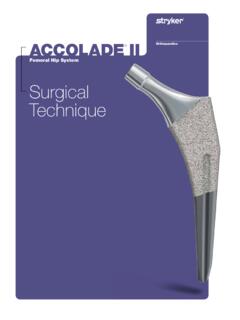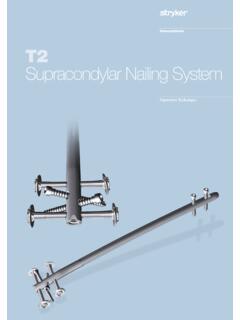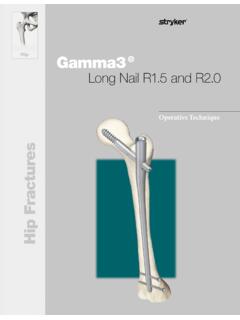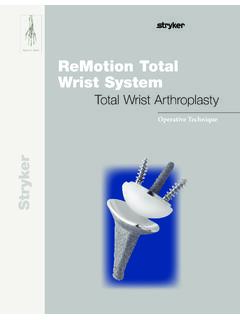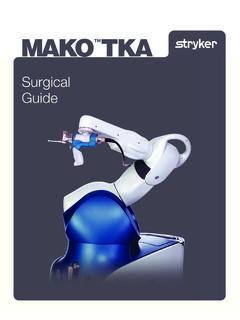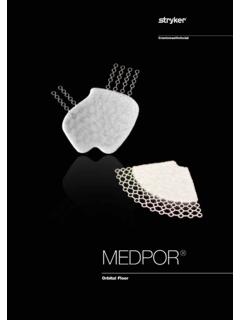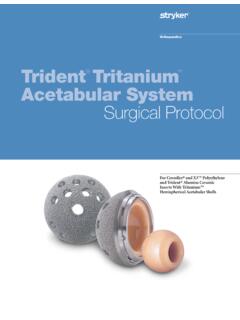Transcription of T2 Alpha - Stryker MedEd
1 T2 Alpha femoral nail GT Operative technique2 ContentsIndications, contraindications and intended use ..3 MRI Safety Information ..4 Additional options ..7 Operative technique ..10 Pre-operative planning ..10 Patient positioning and fracture reduction .. 10 Incision ..11 Entry point ..12 Opening ..13 Guide wire insertion & reaming ..15 Reaming ..16 nail selection ..17 nail insertion ..18 Recon locking mode ..22 antegrade proximal locking mode ..28 Internal apposition / compression mode ..33 External compression mode ..35 Guided distal locking ..36 Freehand distal locking ..45 Advanced locking screws ..47 Set screw and end cap insertion ..50 nail removal ..51 This publication sets forth detailed recommended procedures for using Stryker devices and instruments. It offers guidance that you should heed, but, as with any such technical guide, each surgeon must consider the particular needs of each patient and make appropriate adjustments when and as required.
2 A workshop training is recommended prior to performing your first surgery. All non-sterile devices must be cleaned and sterilized before use. Follow the instructions provided in our cleaning and sterilization guide (OT-RG-1). Multi-component instruments must be disassembled for cleaning. Please refer to the corresponding assembly/disassembly instructions. Please remember that the compatibility** of different product systems has not been tested unless specified otherwise in the product labeling. See package insert (Instructions for Use) (L22000034, L22000035, L22000045, L22000007) for a complete list of potential adverse effects, contraindications, warnings and precautions. The surgeon must discuss all relevant risks including the finite lifetime of the device with the patient when necessary. Use instruments/implants as described inthis operative technique to avoid damageto instruments/implants or bone and AlphaTMFemoral nail GT**Is part of the T2 Alpha Femur antegrade GT/PF Nailing System* *The terms 'all Stryker IM Nailing Systems' / 'all titanium-made Stryker IM Nailing Systems' (described in IFU L22000035 and L22000045) are defined as T2 Alpha Femur antegrade GT/PF Nailing System and T2 Alpha Tibia Nailing document applies to the devices of the T2 Alpha Femur antegrade GT / PF Nailing System, IMN Screws System and IMN Instruments Alpha Femur antegrade GT/PF Nailing SystemIntended useThe T2 Alpha Femur antegrade GT / PF Nailing System is intended for temporary stabilization of bone segments or fragments until bone consolidation has been (Europe)The indications for use of these internal fixation devices include.
3 Fixation of subtrochanteric, intertrochanteric, ipsilateral neck/shaft, comminuted proximal femoral shaft fractures femoral fixation required as a result of pathological disease Temporary stabilization of fractures of the femoral shaft ranging from the femoral neck to the supracondylar regions of the femurContraindicationsThe physician s education, training and professional judgement must be relied upon to choose the most appropriate device and treatment. Conditions presenting an increased risk of failure include: Any active or suspected latent infection or marked local inflammation in or about the affected area. Compromised vascularity that would inhibit adequate blood supply to the fracture or the operative site. Bone stock compromised by disease, infection or prior implantation that can not provide adequate support and/or fixation of the devices. Material sensitivity documented or suspected. Obesity. An overweight or obese patient can produce loads on the implant that can lead to failure of the fixation of the device or to failure of the device itself.
4 Patients having inadequate tissue coverage over the operative site. Implant utilization that would interfere with anatomical structures or physiological performance. Any mental or neuromuscular disorder which would create an unacceptable risk of fixation failure or complications in postoperative care. Other medical or surgical conditions which would preclude the potential benefit of Screws SystemIntended UseThe IMN Screws System is intended to stabilize the intramedullary nail -bone construct for temporary Instruments SystemIntended UseThe IMN Instruments System is intended to enable the implantation and extraction of intramedullary nail and and contraindications4 The MRI safety information provided is based on testing which did not include supplementary devices. If there are supplementary devices ( plates, screws, wires, etc.) present in proximity to the T2 Alpha Femur antegrade GT/PF Nailing System and IMN Screws System, this could result in additional MRI effects and the information provided above may not testing has demonstrated that the T2 Alpha Femur antegrade GT/PF Nailing System and IMN Screws System are MR Conditional.
5 A patient with this device can be safely scanned in an MR system meeting the following conditions: Static magnetic field of or Maximum spatial field gradient of 3,000 gauss/cm (30 T/m) Maximum MR system reported, whole body averaged specific absorption rate (SAR) of 2 W/kg (Normal Operating Mode)Under the scan conditions defined above, the T2 Alpha Femur antegrade GT/PF Nailing System and IMN Screws System are expected to produce a maximum temperature rise of less than C after 15 minutes of continuous non-clinical testing, the image artifact caused by the device extends approximately 27mm from the T2 Alpha Femur antegrade GT/PF Nailing System and IMN Screws System when imaged with a spin echo or gradient echo pulse sequence and a T MRI Safety Information5T2 Alpha femoral nail GTNail diameter 9mm 15mm* nail length240mm 480mm in 20mm incrementsCompression Screw FemurFemoral nail GTAdditional InformationSet ScrewEnd Caps**+5mm( 13mm)+10 m m( 13mm)+1 5 m m( 13mm)+20mm( 13mm)+0mm( 8mm)
6 IMN ScrewsLocking Screw 5mm, 25mm 120mm length 25mm - 60mm in increments 60mm - 120mm in 5mm incrementsAdvanced Locking Screws 5mm, 30mm 100mm length 30mm - 60mm in increments 60mm - 100mm in 5mm incrementsT2 Lag Screws Recon** , 65mm 130mm length*Check with local representative regarding availability of implant sizes** 8mm part of T2 Alpha Tibia Nailing System, 13mm part of Femur antegrade GT/PF Nailing System **Existing screw of T2 Recon Nailing SystemScrew length measures from top of head to tip6 Additional Information45mm37. 5 m m30mm25mm10mm0mmFemoral nail GT0mm0mm33mm70mm / 4 Valgus Bend57mm67mm82mmRoC: 750-1350mm7 Recon ModeDynamic ModeOblique Static ModeInternal Apposition / Compression ModeTransverse Static ModeExternal Apposition / Compression ModeAdditional InformationLocking options8 Additional InformationSterile PackagingThe sterile packaging is designed to minimize user contact with the implant prior to implantation. After the pouch is opened, all implants include a sheath that is introduced into the sterile 1: nail is removed from pouch, sheath is opened and attached to the targeting arm (Fig.)
7 1-3).Fig. 1 Fig. 2 Fig. 39 Additional InformationSterile PackagingExample 2: After removal from pouch, implant is attached to the corresponding screwdriver ( Locking Screw Fig. 4-5 and End Cap Fig. 6-7).Fig. 4 Fig. 5 Fig. 6 Fig. 710 Thorough evaluation of pre-operative radiographs of the affected extremity is critical. Careful radiographic examination of the trochanteric region and intercondylar regions may prevent certain intra-operative proper nail length when using the femoral nail GT should extend from the tip of the greater trochanter to the distal epiphyseal sca techniquePre-operative planningPatient positioning and reductionThe design of the femoral nail GT allows for insertion through the tip of the greater positioning for nail insertion is surgeon dependent. It is recommended to position the patient in the supine position on a fracture table ( ) or in a lateral position on a radiolucent table. Anatomic reduction of the fracture should be performed prior to reaming and nail 811 Incision The tip of the greater trochanter can be located by palpation.
8 Then, a longitudinal skin inci-sion is made 2cm above the greater trochanter extending 3cm towards the iliac crest (Fig. 9). Be prepared to lengthen the incision as greater trochanter can also be located using techniqueApproachFig. 912 Entry point Greater trochanteric femoral nail GTThe entry point is located at the anterior/posterior center of the greater trochanter on the medial edge of the tip (Fig. 10). In the lateral view the entry point is centered at the proximal diaphyseal axis of the medullary canal. If using the recon locking option, ensure that the femoral neck access and T2 Lag Screw Recon trajectory (see Recon Locking Mode Section) is considered when determining entry techniqueEntry pointVerify correct entry point prior to opening the 1013 OpeningThe opening can be achieved by using either the K-wire and Opening Reamer or the curved awl. Insert the K-wire 3mm x 285mm at the identified entry point approximately 2-3cm into the bone. Use power or the Guide Wire Handle to facilitate the Opening Reamer Handle, Opening Reamer Sleeve 13mm, and Opening Reamer Trocar 13mm (Fig.)
9 11). Guide the assembly over the K-wire though the center hole of the trocar until the trocar is fully seated on bone. Use imaging in the anterior and lateral views to confirm placement of the K-wire. If the K-wire is correctly positioned, remove the trocar from the the K-wire is not optimally positioned, the off-center trocar holes can be used to correct the entry point by inserting a second K-wire. To utilize, rotate the trocar into the desired position and place a second K-wire 3 x 285mm through one of the off-center holes (Fig. 12). The distance from the center hole is Once the second K-wire is positioned as desired, remove the initial K-wire and the trocar. If more than of correction is required, 9mm of correction can be achieved by removing the sleeve and trocar assembly from the initial K-wire and reinserting the assembly over the K-wire through one of the off-center holes of the trocar. Fig. 12 Operative techniqueOpening Reamer TrocarOpening Reamer SleeveOpening Reamer 1114 OpeningThen insert a second K-wire through the remaining off-center hole.
10 Once the second K-wire is positioned as desired, remove the initial K-wire and trocar. After verifying that the Opening Reamer Sleeve is fully seated on the bone, advance the Opening Reamer to ream over the K-wire through the Opening Reamer Sleeve until the stop (Fig. 13). If hand reaming is preferred, attach the opening reamer to the Quick Lock Delta Handle and rotate the reamer assembly to open the medullary canal. Remove the techniqueThe Opening Reamer is a front and side cutting instrument and should be used with care to ensure that the sharp edges of the reamer do not inadvertently damage bone or soft of the Opening ReamerSleeve is recommended. The Opening Reamer Sleeve may reduce the risk of heterotropic 1: The medullary canal can be opened with the Curved Awl (Fig. 14.) If the awl is used to open the cortex, use of the Ball Tip Guide Wire and Opening Reamer is required to widen the entry portal. Dense cortical bone may block the tip of the awl during opening of the entry portal.
